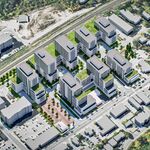The Time is Now
Our Vision
It’s 2015, Toronto has established a reputation as the model city for global
competitiveness; a vibrant, forward thinking local economy; the envy of its
peers. A ranking as the top city in the world for job creation and employment
attraction. Being touted worldwide as the place to be! This is what Toronto
could become in the next 10 years. But to reach that goal, there is work to
be done and it must be done as a community guided by a shared vision and
common sense of purpose..
To achieve this vision, we must act NOW and we must act boldly, or we will
achieve a very different future ...
It started as a whisper, “Did you hear, that multi-national software company
just announced a major investmentâ€â€“ but it wasn’t in Toronto. We shrugged
and life went on. Next, there was an occasional article in the daily paper,
“Major corporations merge to expand market-share†– but it wasn’t in
Toronto. We shrugged and life went on. Until, finally, the whispers became
a roar and suddenly everyone was talking about employment sprawl, traffic
congestion, and under-employment in Toronto. If we continue to shrug and
ignore these warning signs of economic decline, we do so at our peril.
As members of the Mayor’s Economic Competitiveness Advisory Committee,
we, like many other Torontonians, are noticing some disturbing trends in our
city. The economic success that characterized Toronto during the latter half
of the twentieth century has become a historical fact rather than a constant
characteristic of our city. We’ve seen other cities that years ago were playing
catch up to our lead, surpass us in terms of economic growth.
Toronto is at a critical juncture in its ability to retain and stimulate new
investment. In order to create a long-term positive economic growth spiral
that will provide additional jobs, increase assessment, and improve the quality
of life for residents, business owners and workers, we must more strategically
direct our energy, resources and contacts toward collective success. It has
often been said that ‘a good job is the best predictor of good health’.
Our quality of life which includes our social, environmental and economic well-
being, is inextricably linked to today’s global market economy. They are part
of a cycle of sustainable economic growth in which strong positive social and
environmental attributes are key to maintaining and attracting investment.
Sustainability, by definition, requires a long-term vision and a holistic,
integrated and collaborative approach. In the short-term, it is possible
to achieve benefits in one area at the expense of the others. But experience
has taught us that, in the longer-term, all three elements will spiral in the
same direction – virtuously upward or perilously downward.




